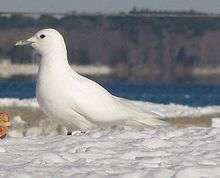Ivory (color)
For other uses, see Ivory (disambiguation).
Carved ivory in Sa'dabad Palace, Iran
| Ivory | |
|---|---|
| Hex triplet | #FFFFF0 |
| sRGBB (r, g, b) | (255, 255, 240) |
| CMYKH (c, m, y, k) | (0, 0, 6, 0) |
| HSV (h, s, v) | (60°, 6%, 100%) |
| Source | X11 |
|
B: Normalized to [0–255] (byte) H: Normalized to [0–100] (hundred) | |
Ivory is an off-white color that resembles ivory, the material from which the teeth and tusks of animals (such as, notably, the elephant and the walrus) is made. It has a very slight tint of yellow.
The first recorded use of ivory as a color name in English was in 1385.[1]
The color "ivory" was included as one of the X11 colors when they were formulated in 1987.
Ivory in nature

Ivory gull
- The ivory-colored cymbidium is a species of orchid.
- Ivory is used adjectivally in the names of several birds to describe their appearance, including the ivory gull, ivory-backed woodswallow, ivory-billed aracari, ivory-billed woodcreeper, ivory-billed woodpecker and ivory-breasted pitta.
References
- ↑ Maerz and Paul A Dictionary of Color New York:1930 McGraw-Hill Page 197; Color Sample of Ivory: Page 43 Plate 10 Color Sample B12
See also
This article is issued from Wikipedia - version of the 6/29/2015. The text is available under the Creative Commons Attribution/Share Alike but additional terms may apply for the media files.